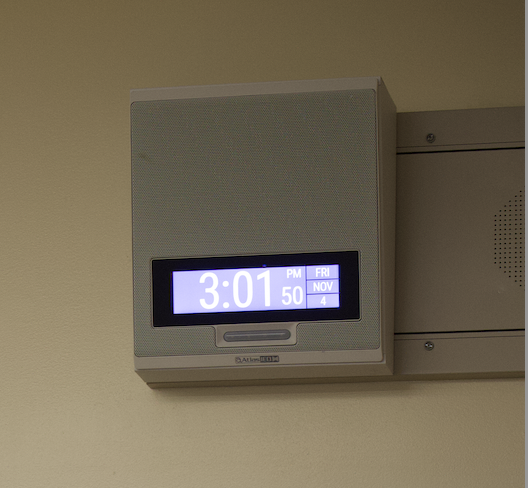Have you noticed that every analog clock in school has been replaced with a new digital one? These new digital clocks not only tell the time, but are part of an intricate new communication system.
New digital clocks were installed in early October in every room across the Palo Alto Unified School District as part of a $3.9 million initiative called the Campus Safety Refresh Project.
The project, approved in July 2021, aims to integrate security camera, clock and speaker systems and desk phones to work together for better security in the entire district in the event of a lockdown, according to PAUSD Chief Technology Officer Derek Moore.
“Having all those pieces tied together to alert people, the messages can be pre-recorded so that it is not somebody thinking of ‘What do I need to say’ in the all call [announcement] overhead paging,” Moore said.
“It [$3.9 million] is a very small percentage in the grand scheme of things, although it’s a big number.”
— Don Austin, PAUSD Superintendent
This new system will help in the event of an active shooter, Moore said, especially now that Palo Alto High School’s security cameras were updated and centralized to one system in June, where they had previously been on three separate systems.
“This [clock speaker] system can dim any noise in the room,” Superintendent Don Austin said. “So if you’re using a projector or a TV screen, and it has volume on it, [and] we’re trying to make an announcement, it will cut that volume down so that you can hear the announcements.”
The project is projected for completion at the end of this calendar year, Moore said, and along with that comes additional training for employees and students.
“If we don’t practice these things, it doesn’t really matter what technology is involved,” Moore said. “The human process of what to do in the event of an incident is what needs to be practiced.”
Paly hasn’t conducted a lockdown drill since before the pandemic, Austin said, but with this new technology, new protocols will have to be practiced.
“We’re gonna be able to test all of that technology but we’re not gonna do the traditional active shooter training where we’re going to rattle doors and have people hide,” Austin said.
The clocks, Atlas IEP IP speakers, are all interconnected through wifi and have the capabilities of broadcasting bells on a predetermined schedule but also can make announcements to specific classrooms in real time from the administration office.
The third component, which Moore said should come by the end of the calendar year, are classroom desk phones connected through a network. These will replace the old call buttons and phones currently in each classroom.
“This [clock speaker] system can dim any noise in the room. So if you’re using a projector or a TV screen, and it has volume on it, [and] we’re trying to make an announcement, it will cut that volume down so that you can hear the announcements.”
— Don Austin, PAUSD Superintendent
“[In the past] if a teacher dialed in that there was an issue from their phone, the police department wouldn’t have known what room that call came from,” Austin said. “They would’ve only seen it as a generic number from the school. And now, we can pinpoint to classrooms. So our accuracy and ability to communicate is much better.”
With new technology being implemented across the entire district, the cost is high. According to Austin, the project’s overall $3.9 million budget for the budget came from the district’s $500 million bond, a sum of money that is tax money approved by voters that can be used for improvements — in this case, technology.
“It [$3.9 million] is a very small percentage in the grand scheme of things, although it’s a big number,” Austin said.
Moore said the $3.9 million has been invested into a valuable piece of district security technology.
“Through the use of drills and kind of training you get used to hearing these and knowing what to do in the event that an unfortunate incident does happen,” Moore said. “It’s kind of the thinking of putting all those pieces together into an integrated system opposed to using human beings as the connector and relying on some connection pieces in the event of an incident.”



